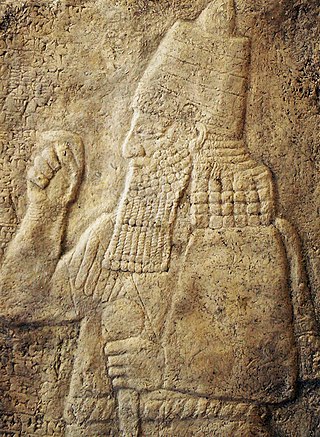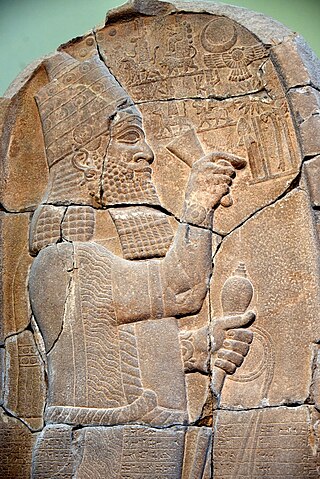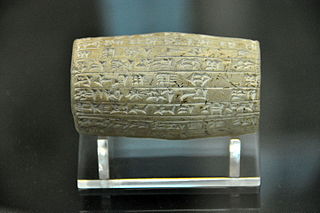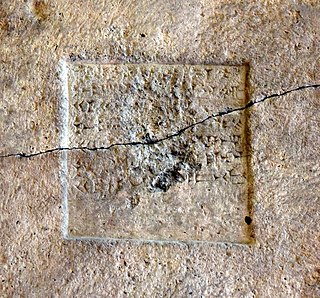
Nineveh, also known in early modern times as Kouyunjik, was an ancient Assyrian city of Upper Mesopotamia, located in the modern-day city of Mosul in northern Iraq. It is located on the eastern bank of the Tigris River and was the capital and largest city of the Neo-Assyrian Empire, as well as the largest city in the world for several decades. Today, it is a common name for the half of Mosul that lies on the eastern bank of the Tigris, and the country's Nineveh Governorate takes its name from it.

Sennacherib was the king of the Neo-Assyrian Empire from the death of his father Sargon II in 705 BC to his own death in 681 BC. The second king of the Sargonid dynasty, Sennacherib is one of the most famous Assyrian kings for the role he plays in the Hebrew Bible, which describes his campaign in the Levant. Other events of his reign include his destruction of the city of Babylon in 689 BC and his renovation and expansion of the last great Assyrian capital, Nineveh.

The 7th century BC began the first day of 700 BC and ended the last day of 601 BC.

The Hanging Gardens of Babylon were one of the Seven Wonders of the Ancient World listed by Hellenic culture. They were described as a remarkable feat of engineering with an ascending series of tiered gardens containing a wide variety of trees, shrubs, and vines, resembling a large green mountain constructed of mud bricks. It was said to have been built in the ancient city of Babylon, near present-day Hillah, Babil province, in Iraq. The Hanging Gardens' name is derived from the Greek word κρεμαστός, which has a broader meaning than the modern English word "hanging" and refers to trees being planted on a raised structure such as a terrace.

Esarhaddon, also spelled Essarhaddon, Assarhaddon and Ashurhaddon was the king of the Neo-Assyrian Empire from the death of his father Sennacherib in 681 BC to his own death in 669. The third king of the Sargonid dynasty, Esarhaddon is most famous for his conquest of Egypt in 671 BC, which made his empire the largest the world had ever seen, and for his reconstruction of Babylon, which had been destroyed by his father.

Nabopolassar was the founder and first king of the Neo-Babylonian Empire, ruling from his coronation as king of Babylon in 626 BC to his death in 605 BC. Though initially only aimed at restoring and securing the independence of Babylonia, Nabopolassar's uprising against the Neo-Assyrian Empire, which had ruled Babylonia for more than a century, eventually led to the complete destruction of the Assyrian Empire and the rise of the Neo-Babylonian Empire in it's place.

Ashurbanipal was the king of the Neo-Assyrian Empire from 669 BCE to his death in 631. He is generally remembered as the last great king of Assyria. Inheriting the throne as the favored heir of his father Esarhaddon, Ashurbanipal's 38-year reign was among the longest of any Assyrian king. Though sometimes regarded as the apogee of ancient Assyria, his reign also marked the last time Assyrian armies waged war throughout the ancient Near East and the beginning of the end of Assyrian dominion over the region.

Shammuramat, also known as Sammuramat or Shamiram, was a powerful queen of the Neo-Assyrian Empire. Beginning her career as the primary consort of the king Shamshi-Adad V, Shammuramat reached an unusually prominent position in the reign of her son Adad-nirari III. Though there is dispute in regard to Shammuramat's formal status and position, and if she should be considered a co-regent, it is clear that she was among the most powerful and influential women of the ancient Near East; she is the only known Assyrian queen to have retained her status as queen after the death of her husband and the only known ancient Assyrian woman to have partaken in, and perhaps even led, a military campaign.
Seton Howard Frederick Lloyd, CBE, was an English archaeologist. He was President of the British School of Archaeology in Iraq, Director of the British Institute of Archaeology at Ankara, Professor of Western Asiatic Archaeology in the Institute of Archaeology, University of London (1962–1969).

The Neo-Assyrian Empire was the fourth and penultimate stage of ancient Assyrian history and the final and greatest phase of Assyria as an independent state. Beginning with the accession of Adad-nirari II in 911 BC, the Neo-Assyrian Empire grew to dominate the ancient Near East throughout much of the 8th and 7th centuries BC, becoming the largest empire in history up to that point. Because of its geopolitical dominance and ideology based in world domination, the Neo-Assyrian Empire is by many researchers regarded to have been the first world empire in history. At its height, the empire was the strongest military power in the world and ruled over all of Mesopotamia, the Levant and Egypt, as well as portions of Anatolia, Arabia and modern-day Iran and Armenia.

Babylon is the name of an ancient city located on the lower Euphrates river in southern Mesopotamia. Babylon functioned as the main cultural and political centre of the Akkadian-speaking region of Babylonia, with its rulers establishing two important empires in antiquity, namely the 18th century BC Old Babylonian Empire and the 7th-6th century BC Neo-Babylonian Empire, and the city would also be used as a regional capital of other empires, such as the Achaemenid Empire. Babylon was one of the most important urban centres of the ancient Near East until its decline during the Hellenistic period.
Tarbiṣu was an ancient city about 3 miles north of Nineveh.

A screw pump is a positive-displacement pump that use one or several screws to move fluid solids or liquids along the screw(s) axis.

The Lachish reliefs are a set of Assyrian palace reliefs narrating the story of the Assyrian victory over the kingdom of Judah during the siege of Lachish in 701 BCE. Carved between 700 and 681 BCE, as a decoration of the South-West Palace of Sennacherib in Nineveh, the relief is today in the British Museum in London, and was included as item 21 in the BBC Radio 4 series A History of the World in 100 Objects by the museum's former director Neil MacGregor. The palace room, where the relief was discovered in 1845–1847, was fully covered with the "Lachish relief" and was 12 metres (39 ft) wide and 5.10 metres (16.7 ft) long. The Lion Hunt of Ashurbanipal sequence was found in the same palace.

Naqiʾa or Naqia (Akkadian: Naqīʾa, also known as Zakutu, was a wife of the Assyrian king Sennacherib and the mother of his son and successor Esarhaddon. Naqiʾa is the best documented woman in the history of the Neo-Assyrian Empire and she reached an unprecedented level of prominence and public visibility; she was perhaps the most influential woman in Assyrian history. She is one of the few ancient Assyrian women to be depicted in artwork, to commission her own building projects, and to be granted laudatory epithets in letters by courtiers. She is also the only known ancient Assyrian figure other than kings to write and issue a treaty.
Stephanie Mary Dalley FSA is a British Assyriologist and scholar of the Ancient Near East. She has retired as a teaching Fellow from the Oriental Institute, Oxford. She is known for her publications of cuneiform texts and her investigation into the Hanging Gardens of Babylon, and her proposal that it was situated in Nineveh, and constructed during Sennacherib's rule.

The timeline of ancient Assyria can be broken down into three main eras: the Old Assyrian period, Middle Assyrian Empire, and Neo-Assyrian Empire. Modern scholars typically also recognize an Early period preceding the Old Assyrian period and a post-imperial period succeeding the Neo-Assyrian period.

The Sargonid dynasty was the final ruling dynasty of Assyria, ruling as kings of Assyria during the Neo-Assyrian Empire for just over a century from the ascent of Sargon II in 722 BC to the fall of Assyria in 609 BC. Although Assyria would ultimately fall during their rule, the Sargonid dynasty ruled the country during the apex of its power and Sargon II's three immediate successors Sennacherib, Esarhaddon and Ashurbanipal are generally regarded as three of the greatest Assyrian monarchs. Though the dynasty encompasses seven Assyrian kings, two vassal kings in Babylonia and numerous princes and princesses, the term Sargonids is sometimes used solely for Sennacherib, Esarhaddon and Ashurbanipal.
The post-imperial period was the final stage of ancient Assyrian history, covering the history of the Assyrian heartland from the fall of the Neo-Assyrian Empire in 609 BC to the final sack and destruction of Assur, Assyria's ancient religious capital, by the Sasanian Empire c. AD 240. There was no independent Assyrian state during this time, with Assur and other Assyrian cities instead falling under the control of the successive Median, Neo-Babylonian, Achaemenid, Seleucid and Parthian empires. The period was marked by the continuance of ancient Assyrian culture, traditions and religion, despite the lack of an Assyrian kingdom. The ancient Assyrian dialect of the Akkadian language went extinct however, completely replaced by Aramaic by the 5th century BC.

Sargon II ruled the Neo-Assyrian Empire from 722 to 705 BC as one of its most successful kings. In his final military campaign, Sargon was killed in battle in the south-eastern Anatolian region Tabal and the Assyrian army was unable to retrieve his body, which meant that he could not undergo the traditional royal Assyrian burial. In ancient Mesopotamia, not being buried was believed to condemn the dead to becoming a hungry and restless ghost for eternity. As a result, the Assyrians believed that Sargon must have committed some grave sin in order to suffer this fate. His son and successor Sennacherib, convinced of Sargon's sin, consequently spent much effort to distance himself from his father and to rid the empire from his work and imagery. Sennacherib's efforts led to Sargon only rarely being mentioned in later texts. When modern Assyriology took form in Western Europe in the 18th century, historians mainly followed the writings of classical Greco-Roman authors and the descriptions of Assyria in the Hebrew Bible for information. Given that Sargon is barely mentioned in either, he was consequently forgotten, the then prevalent historical reconstructions placing Sennacherib as the direct successor of Sargon's predecessor Shalmaneser V and identifying Sargon as an alternate name for one of the more well-known kings.



























